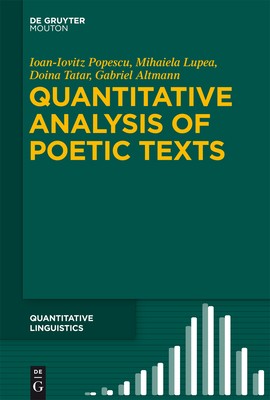
- We will send in 10–14 business days.
- Author: Ioan-Iovitz Popescu
- Publisher: Walter de Gruyter
- Year: 2015
- Pages: 288
- ISBN-10: 3110336057
- ISBN-13: 9783110336054
- Format: 15.6 x 23.4 x 1.8 cm, hardcover
- Language: English
- SAVE -10% with code: EXTRA
Reviews
Description
The book presents methods for the objective analysis of poetic language. Common objects of literary studies such as rhythm, semantic explications, interpretation and personal impressions are avoided. Only those properties of poetic texts are taken into account that could be quantified. The major chapters contain the analysis of phonic phenomena (frequency, euphony, assonance, alliteration, aggregation, rhyme), word properties (aspects of frequency, length, richness, word classes, sequences of word properties, characterisations). The synergetic control cycle is the result of the study of mutual links between properties. For all methods both statistical tests (evaluation, comparison), theoretical derivations (models), and examples are presented.
The book is dedicated to the work of the famous Romanian poet Mihai Eminescu whose complete work was analysed, which made detailed illustrations of the method possible. The methods can be used mutatis mutandis for any language and text. It is the first comprehensive quantitative analysis of a poetic work.EXTRA 10 % discount with code: EXTRA
The promotion ends in 9d.22:30:24
The discount code is valid when purchasing from 10 €. Discounts do not stack.
- Author: Ioan-Iovitz Popescu
- Publisher: Walter de Gruyter
- Year: 2015
- Pages: 288
- ISBN-10: 3110336057
- ISBN-13: 9783110336054
- Format: 15.6 x 23.4 x 1.8 cm, hardcover
- Language: English English
The book presents methods for the objective analysis of poetic language. Common objects of literary studies such as rhythm, semantic explications, interpretation and personal impressions are avoided. Only those properties of poetic texts are taken into account that could be quantified. The major chapters contain the analysis of phonic phenomena (frequency, euphony, assonance, alliteration, aggregation, rhyme), word properties (aspects of frequency, length, richness, word classes, sequences of word properties, characterisations). The synergetic control cycle is the result of the study of mutual links between properties. For all methods both statistical tests (evaluation, comparison), theoretical derivations (models), and examples are presented.
The book is dedicated to the work of the famous Romanian poet Mihai Eminescu whose complete work was analysed, which made detailed illustrations of the method possible. The methods can be used mutatis mutandis for any language and text. It is the first comprehensive quantitative analysis of a poetic work.

Reviews